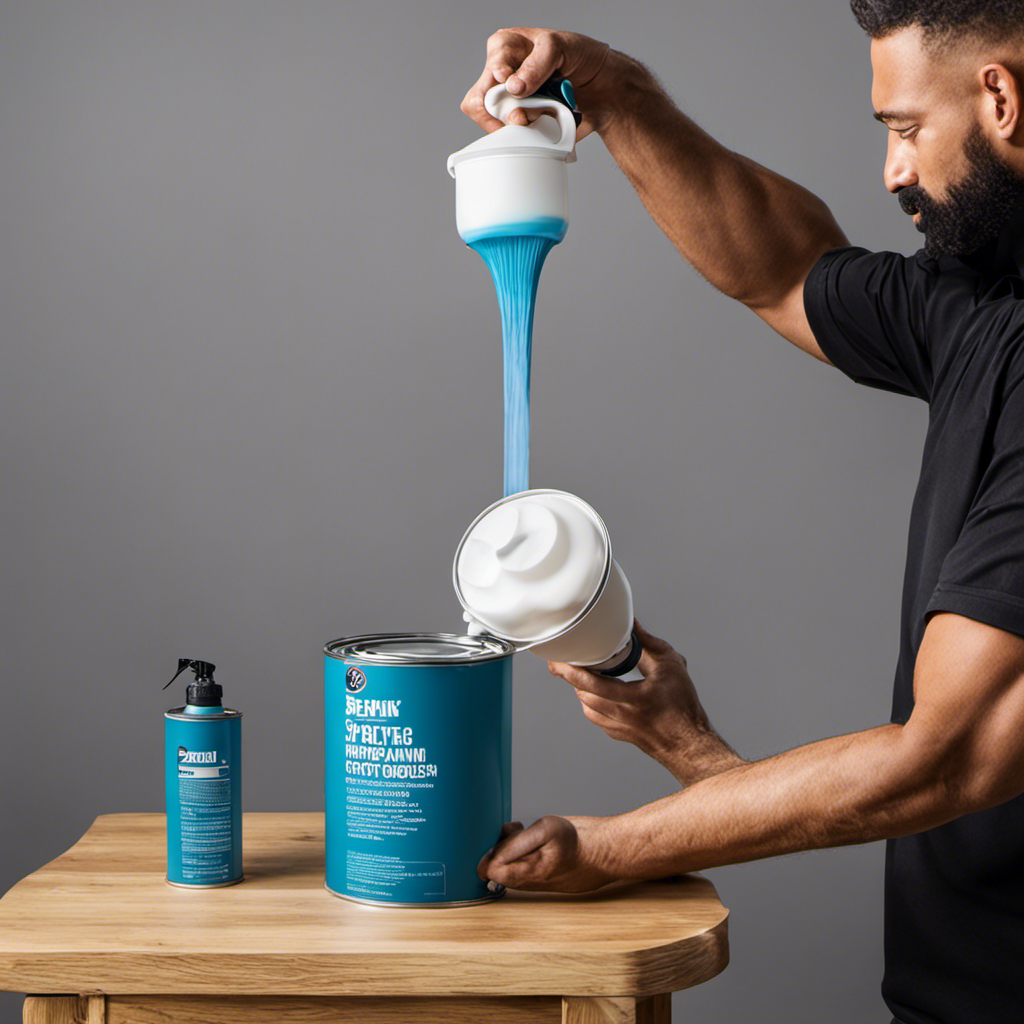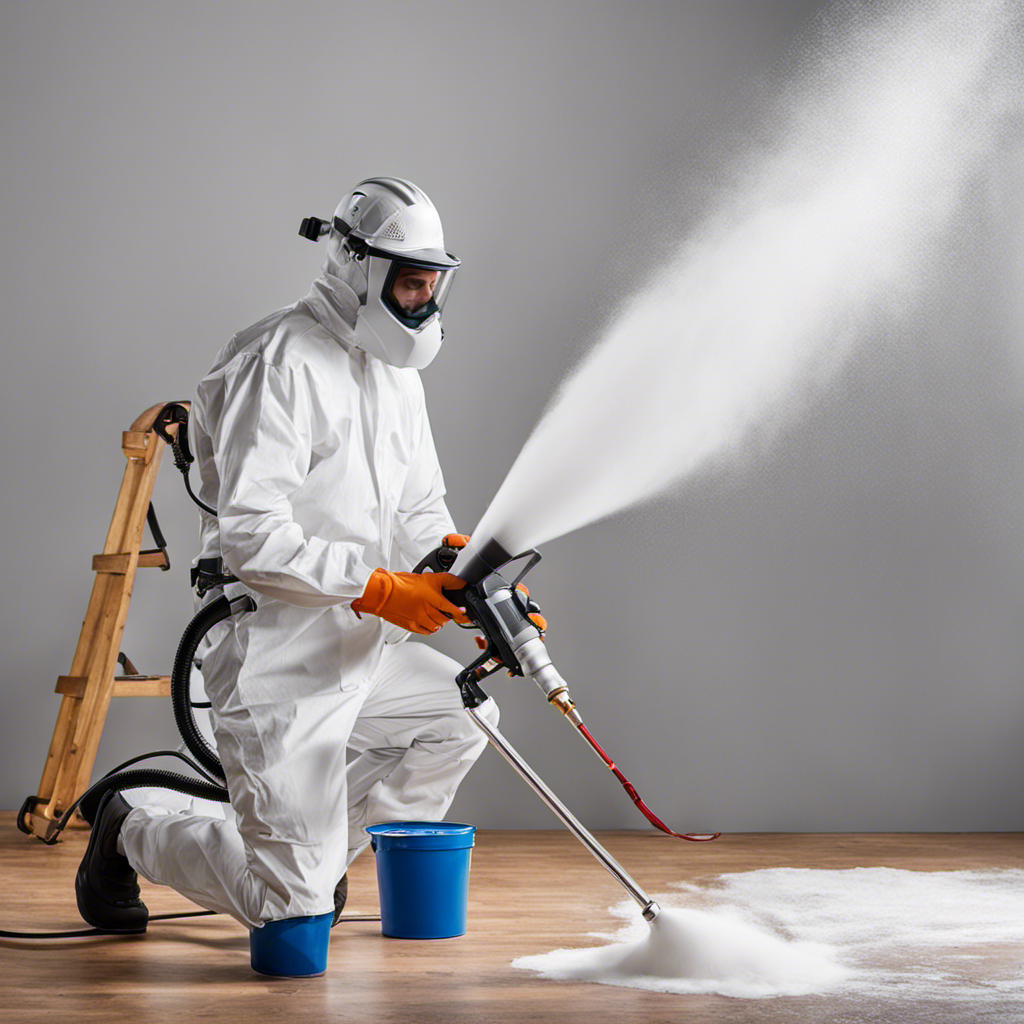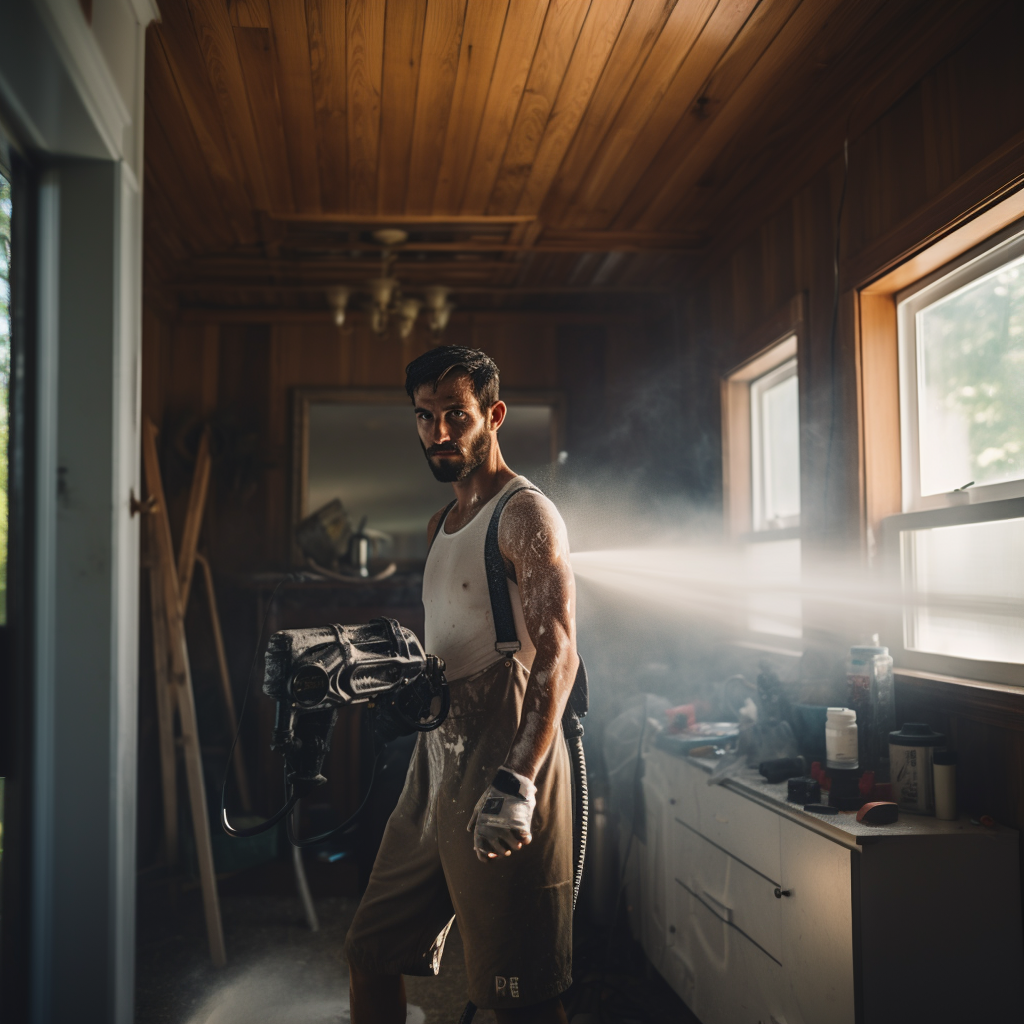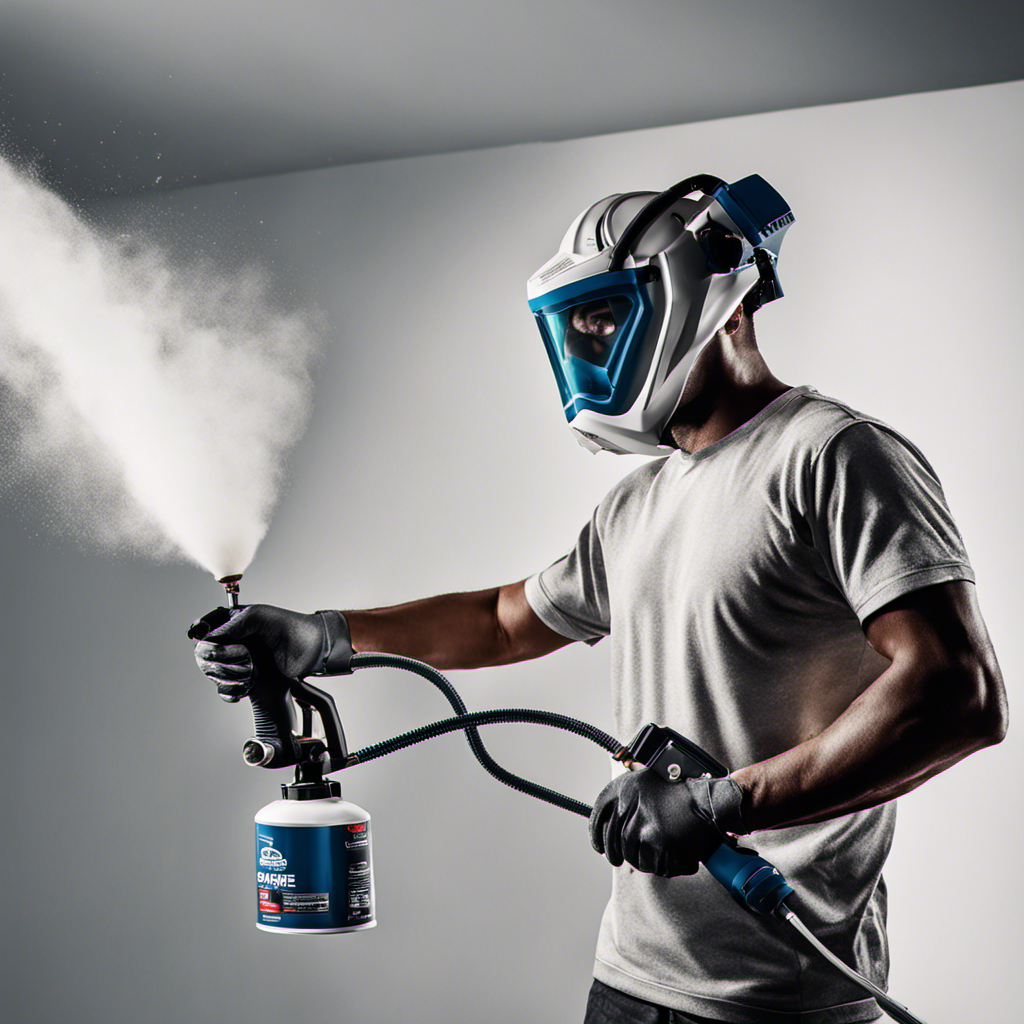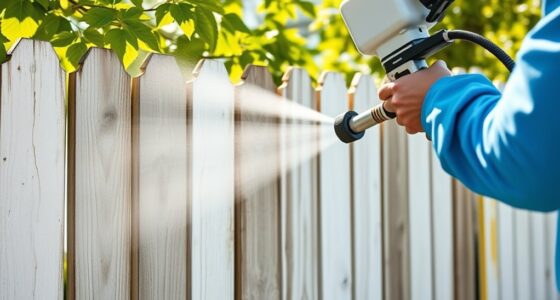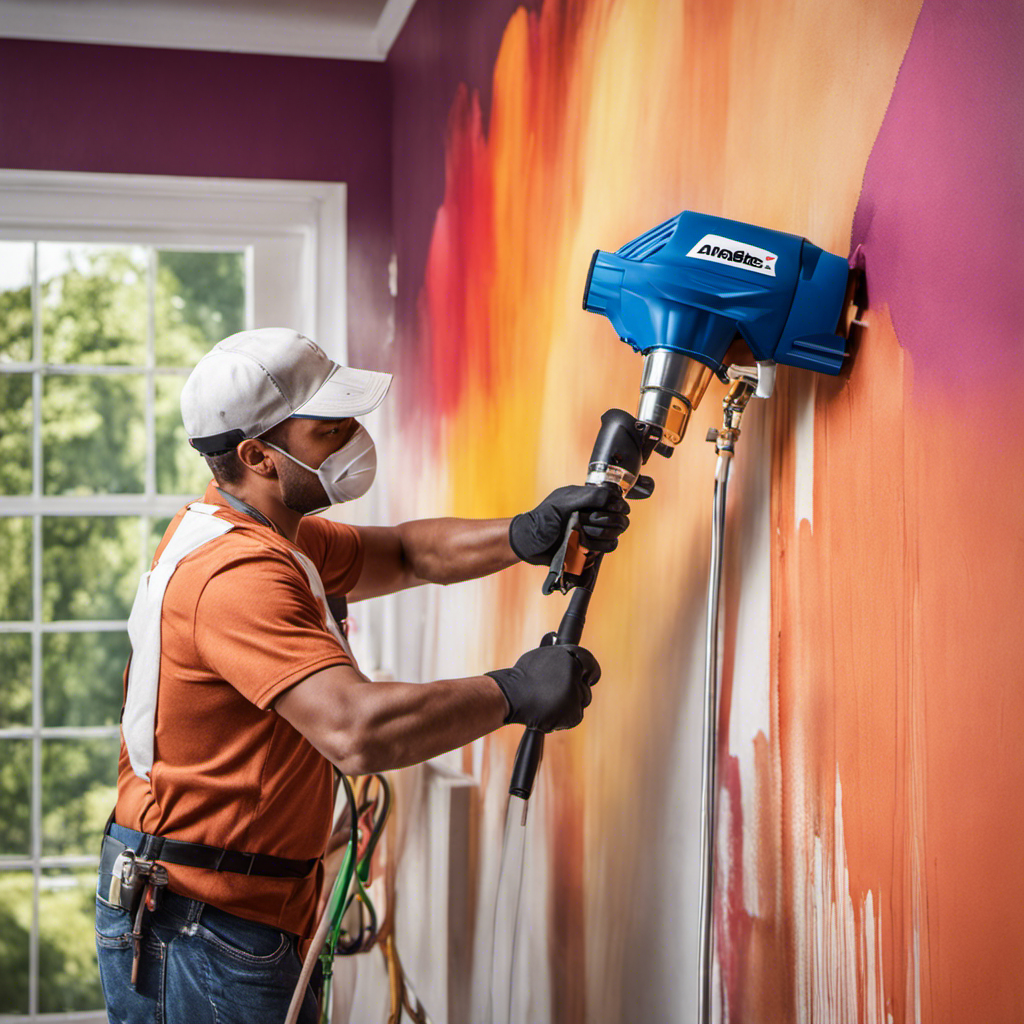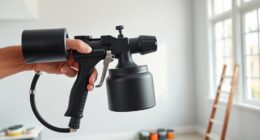Thinning latex paint is essential to achieve excellent, professional outcomes with airless sprayers. It promotes a seamless and consistent application, avoiding blockages and drips, while also enhancing the paint’s adhesion and longevity. As various spraying patterns demand distinct viscosity levels, it is vital to conduct tests and make adjustments before covering the entire surface.
Following manufacturer instructions and using measuring tools is key. Regularly checking and adjusting throughout the process can troubleshoot common issues.
With these tips, painters can achieve smooth, clog-free results every time.
Key Takeaways
- Thinning latex paint is important to achieve smooth and flawless results with airless sprayers.
- Different spray patterns require different consistency, with thin paint for fine finishes and thicker paint for heavier coatings and textured surfaces.
- It is crucial to maintain the proper ratio of paint to thinners, following manufacturer’s instructions and regularly checking and adjusting the consistency throughout the painting process.
- Troubleshooting common issues such as clogged spray tips and overspray can be resolved by cleaning the sprayer, adjusting spray tip size and pressure, and applying the paint in overlapping strokes.
Understanding the Importance of Thinning Latex Paint
Thinning latex paint is important to achieve smooth and flawless results, ensure even application, prevent clogging and splattering, improve paint adhesion to surfaces, and enhance the durability and longevity of the paint job.
Improper thinning can have a negative effect on paint performance, leading to streaks, uneven coverage, and poor adhesion. To avoid these issues, it is recommended to use a professional-grade paint thinner.
Professional-grade paint thinners are specifically formulated to maintain the integrity and performance of latex paint, ensuring optimal results. They are designed to provide the perfect balance between viscosity and flow, allowing for easy application and improved paint adhesion.
Additionally, professional-grade thinners are often less prone to causing clogs and splatters, resulting in a more efficient and enjoyable painting experience.
Choosing the Right Thinning Agent for Your Airless Sprayer
To achieve optimal performance with an airless sprayer, it is crucial to select the appropriate thinning agent for the job. The best thinning agent for latex paint depends on various factors, including the desired consistency, the type of paint being used, and the surface being painted.
Water-based thinners are commonly used and readily available, providing an affordable option to reduce viscosity. Floetrol is another popular choice as it enhances smoothness and prevents clogs. Acrylic thinning agents are specialized mediums that can transform viscosity, while mineral spirits are an alternative option that requires safety precautions. Professional-grade paint thinners are also available for those seeking high-quality performance.
It is important to follow the manufacturer’s recommendations and take safety precautions when using any thinning agent to ensure smooth, clog-free results.
Adjusting Paint Consistency for Different Spray Patterns
Achieving the desired spray pattern requires adjusting the consistency of the paint for different applications. When using an airless sprayer, it is crucial to adjust the paint consistency to achieve optimal results.
Thinning the paint allows for a smoother and more even application, preventing clogs and splattering. For fine finishes and detailed work, thin the paint to a more watery consistency. On the other hand, for heavier coatings and textured surfaces, a thicker paint consistency is needed.
It is essential to test the consistency before spraying on the entire surface and make adjustments as needed. By maintaining the proper ratio of paint to thinners and regularly checking and adjusting the consistency throughout the painting process, one can achieve excellent results with an airless sprayer.
Maintaining the Proper Ratio of Paint to Thinners
Maintaining the proper ratio of paint to thinners ensures optimal performance and allows for adjustments based on desired coverage and viscosity. To achieve the best results, it is crucial to measure the paint ratios accurately. This can be done using measuring tools such as graduated containers or scales. By following the manufacturer’s instructions for recommended ratios and using the appropriate measuring tools, one can ensure consistency in the paint mixture.
To add a level of sophistication to the writing, a 2 column and 4 row table can be incorporated, showcasing different types of thinning agents and their characteristics:
| Thinning Agents | Characteristics |
|---|---|
| Water-based thinners | Reduce viscosity, readily available and affordable |
| Floetrol | Enhances smoothness, prevents clogs |
| Acrylic thinning agents | Transform viscosity, specialized mediums available |
| Mineral spirits | Alternative option, effective but requires safety precautions |
| Professional-grade paint thinners | High-quality, specifically designed for optimal results |
Step-by-Step Guide to Thinning Latex Paint for Airless Sprayers
The first step in thinning latex paint for airless sprayers is to gather all the necessary materials and equipment.
To achieve smooth, clog-free results, it is important to choose the best thinning agent and take measures to avoid paint splattering. Water-based thinners are commonly used as they reduce viscosity and are readily available and affordable. Another popular option is Floetrol, which not only enhances smoothness but also prevents clogs. Acrylic thinning agents can also be used to transform viscosity, with specialized mediums available for specific needs. However, if you prefer an alternative, mineral spirits can be effective, although safety precautions should be taken.
It is crucial to adjust the paint consistency based on the desired spray pattern, with thinner paint for fine finishes and thicker paint for heavier coatings. Regularly testing and adjusting the consistency throughout the process is essential for optimal results.
Following the manufacturer’s instructions for the proper ratio of paint to thinners, using measuring tools for accurate mixing, and avoiding excessive thinning are all important factors to consider. By following these steps and guidelines, paint splattering can be avoided, ensuring a smooth and professional finish.
Tips for Achieving a Smooth and Even Application of Paint
To ensure a flawless application, painters should focus on applying the paint evenly and smoothly. Achieving smooth finishes and preventing splattering are key goals when it comes to painting. Here are some tips to help painters achieve a smooth and even application of paint:
-
Use the right tools: Choose high-quality brushes or rollers that are suitable for the type of paint being used. This will help to ensure a smooth and even application.
-
Prepare the surface: Properly clean and prepare the surface before painting to ensure better adhesion and a smoother finish.
-
Thin the paint if necessary: Depending on the type of paint and the desired consistency, thinning the paint may be necessary to achieve a smooth application.
-
Apply multiple thin coats: Instead of applying one thick coat, it is better to apply multiple thin coats. This will help to prevent splattering and achieve a smoother finish.
-
Use proper technique: Follow proper painting techniques such as using long, even strokes and avoiding excessive pressure. This will help to achieve a smooth and even application of paint.
Troubleshooting Common Issues With Thinning Latex Paint
Clean the sprayer regularly to prevent clogs and ensure optimal performance. When using airless sprayers to apply latex paint, it is important to be aware of common issues that may arise and have troubleshooting techniques in mind. One common issue is the paint being too thick, which can lead to clogs and uneven spray patterns. To address this, thinning the latex paint is necessary. Using a 2 column and 3 row table, here are some troubleshooting techniques for thinning latex paint:
| Common Issues with Airless Sprayers | Troubleshooting Techniques for Thinning Latex Paint |
|---|---|
| Clogged spray tip | Clean the spray tip or replace if necessary |
| Uneven spray pattern | Adjust spray tip size and pressure |
| Overspray | Maintain a consistent distance from the surface |
Expert Advice for Striving for Excellence in Airless Spraying
Seeking advice and guidance from experienced painters can greatly contribute to one’s pursuit of excellence in airless spraying. These experts have honed their skills and developed techniques that can improve efficiency and overall results. By learning from their expertise, individuals can enhance their own spraying techniques and achieve better outcomes.
Some expert techniques for improving efficiency in airless spraying include:
- Proper paint thinning: Ensuring the paint is properly thinned for the specific spraying application can result in smoother and more even coats.
- Spray pattern adjustment: Understanding how to adjust the spray pattern to match the surface being painted can optimize coverage and reduce overspray.
- Sprayer maintenance: Regular cleaning and maintenance of the airless sprayer can prevent clogs and ensure consistent performance.
- Paint viscosity control: Monitoring and adjusting the paint viscosity throughout the painting process can help maintain optimal spraying consistency.
- Overlapping strokes: Applying the paint in overlapping strokes can help achieve uniform coverage and eliminate streaks or lines.
Ensuring Clog-Free Results With Proper Thinning Techniques
Thinning latex paint for airless sprayers is essential to ensure smooth and clog-free results. Proper thinning techniques play a crucial role in preventing clogs and maintaining the efficiency of the sprayer.
To achieve the right consistency, it is recommended to follow the manufacturer’s instructions regarding the paint-to-thinner ratio. Measuring tools can be used for accurate mixing. It is important to avoid excessive thinning, as it can negatively affect the performance of the paint.
Regularly checking and adjusting the consistency throughout the painting process is also recommended. By ensuring the paint is properly thinned, painters can prevent clogs in the sprayer and achieve a flawless finish.
Taking these precautions and following the right thinning techniques will help painters achieve optimal results with their airless sprayers.
Best Practices for Thinning Latex Paint for Textured Surfaces
Achieving optimal results with textured surfaces involves adjusting the paint consistency and following recommended techniques for a flawless finish. To evoke emotion in the audience, here are some best thinning agents and techniques for achieving texture:
- Water-based thinners: These readily available and affordable thinners reduce viscosity and ensure smooth application.
- Floetrol: This thinning agent enhances smoothness and prevents clogs, resulting in a professional-looking finish.
- Acrylic thinning agents: These specialized mediums transform viscosity and provide options for achieving desired texture.
- Mineral spirits: While requiring safety precautions, mineral spirits can effectively thin latex paint for textured surfaces.
- Professional-grade paint thinners: These high-quality thinners offer precise control over paint consistency, ensuring excellent results.
Final Tips and Tricks for Thinning Latex Paint With Airless Sprayers
To ensure optimal performance and efficiency, professional painters using airless sprayers should regularly inspect and maintain their equipment.
Thinning latex paint is a crucial step in achieving smooth and clog-free results. When using airless sprayers, it is important to take safety precautions when handling thinning agents.
Water-based thinners, such as Floetrol and acrylic thinning agents, are popular choices for thinning latex paint. These options not only reduce viscosity but also enhance smoothness and prevent clogs. However, if professionals prefer alternatives, mineral spirits can be used with proper safety precautions.
Maintaining the proper ratio of paint to thinners is essential for achieving the desired consistency. By following manufacturer’s instructions and regularly checking and adjusting the consistency, professional painters can ensure flawless results.
Thinning latex paint with airless sprayers requires knowledge, precision, and attention to detail to achieve the best possible outcome.
Frequently Asked Questions
Can I Use Oil-Based Thinners for Latex Paint With an Airless Sprayer?
Using oil-based thinners for latex paint in an airless sprayer can have both pros and cons.
On the positive side, oil-based thinners can help reduce the viscosity of latex paint, making it easier to spray and resulting in a smoother finish.
However, there are some drawbacks to consider. Oil-based thinners can have a strong odor and may require additional safety precautions. Additionally, they may not be compatible with all types of airless sprayers.
It’s important to carefully read the manufacturer’s instructions and test the compatibility before using oil-based thinners with a latex paint in an airless sprayer.
Are There Any Specific Safety Precautions I Should Take When Using Mineral Spirits as a Thinning Agent?
When using mineral spirits as a thinning agent for latex paint, it is important to take specific safety precautions. These include:
- Working in a well-ventilated area
- Wearing gloves and protective eyewear
- Avoiding inhalation and skin contact
Mineral spirits are flammable, so it is crucial to keep them away from open flames or sparks. Additionally, proper disposal of used mineral spirits is necessary to prevent environmental contamination.
Following these precautions ensures a safe and successful painting experience.
How Can I Tell if the Paint Consistency Is Correct Before Spraying It on the Entire Surface?
To test the paint consistency before spraying it on the entire surface, one can perform a simple viscosity test. This involves dipping a viscosity cup or a stir stick into the paint and observing how it flows off. The paint should have a smooth, even flow without any clumps or excessive dripping.
The importance of proper paint consistency cannot be understated, as it ensures an even application, prevents clogging, and promotes better adhesion to surfaces. Maintaining the correct consistency is key to achieving smooth, clog-free results when using airless sprayers.
What Should I Do if My Spray Tip Keeps Getting Clogged While Using an Airless Sprayer?
If a spray tip keeps getting clogged while using an airless sprayer, there are several solutions to consider.
First, make sure the paint is properly thinned to the manufacturer’s recommended consistency.
Secondly, check the spray tip for any debris or buildup and clean it thoroughly.
If the clogging persists, try using a larger spray tip size or reducing the pressure.
Regular maintenance and cleaning of the sprayer can also help prevent clogs.
Are There Any Special Techniques or Tips for Achieving a Fine Finish When Thinning Latex Paint for Airless Spraying?
Achieving a fine finish when thinning latex paint for airless spraying requires attention to detail and proper technique. To achieve an optimal spray pattern, it is important to thin the paint to the correct consistency and maintain a consistent distance from the surface. This helps prevent overspray and ensures even application.
Additionally, using the appropriate spray tip size and pressure can also contribute to a fine finish. By following these tips, painters can achieve smooth, clog-free results with their airless sprayers.
Conclusion
In conclusion, thinning latex paint for airless sprayers is a crucial step in achieving flawless and clog-free results. By understanding the importance of paint consistency, choosing the right thinning agent, and maintaining the proper ratio, painters can ensure smooth and even application.
Following a step-by-step guide, seeking expert advice, and practicing best practices will help painters strive for excellence in airless spraying. By employing these techniques, painters can avoid common issues and achieve professional-quality results.
So, remember to take the time to thin your paint properly for optimal performance and a flawless finish.
Franz came aboard the Paint Sprayer Zone team with a background in both journalism and home renovation. His articulate writing style, combined with a passion for DIY projects, makes him an invaluable asset. Franz has a knack for breaking down technical jargon into easy-to-understand content, ensuring that even the most novice of readers can grasp the complexities of paint sprayers.
